lock VOLVO S60 2015 Owner´s Manual
[x] Cancel search | Manufacturer: VOLVO, Model Year: 2015, Model line: S60, Model: VOLVO S60 2015Pages: 406, PDF Size: 11.26 MB
Page 4 of 406
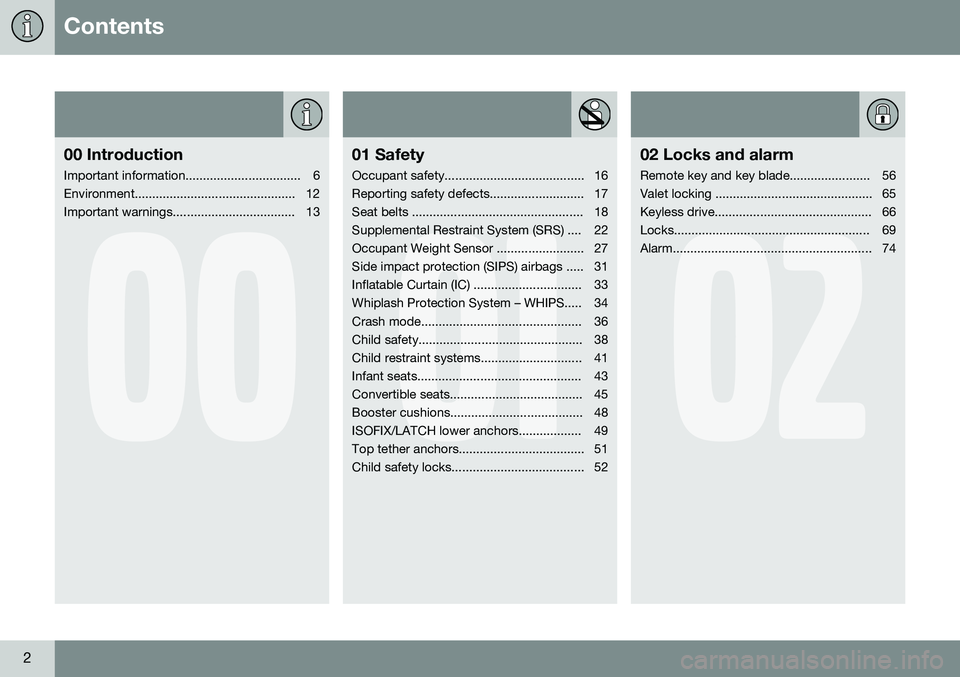
Contents
2
00
00 Introduction
Important information................................. 6
Environment.............................................. 12
Important warnings................................... 13
01
01 Safety
Occupant safety........................................ 16
Reporting safety defects........................... 17
Seat belts ................................................. 18
Supplemental Restraint System (SRS) .... 22
Occupant Weight Sensor ......................... 27
Side impact protection (SIPS) airbags ..... 31
Inflatable Curtain (IC) ............................... 33
Whiplash Protection System – WHIPS..... 34
Crash mode.............................................. 36
Child safety............................................... 38
Child restraint systems............................. 41
Infant seats............................................... 43
Convertible seats...................................... 45
Booster cushions...................................... 48
ISOFIX/LATCH lower anchors.................. 49
Top tether anchors.................................... 51
Child safety locks...................................... 52
02
02 Locks and alarm
Remote key and key blade....................... 56
Valet locking ............................................. 65
Keyless drive............................................. 66
Locks........................................................ 69
Alarm......................................................... 74
Page 8 of 406
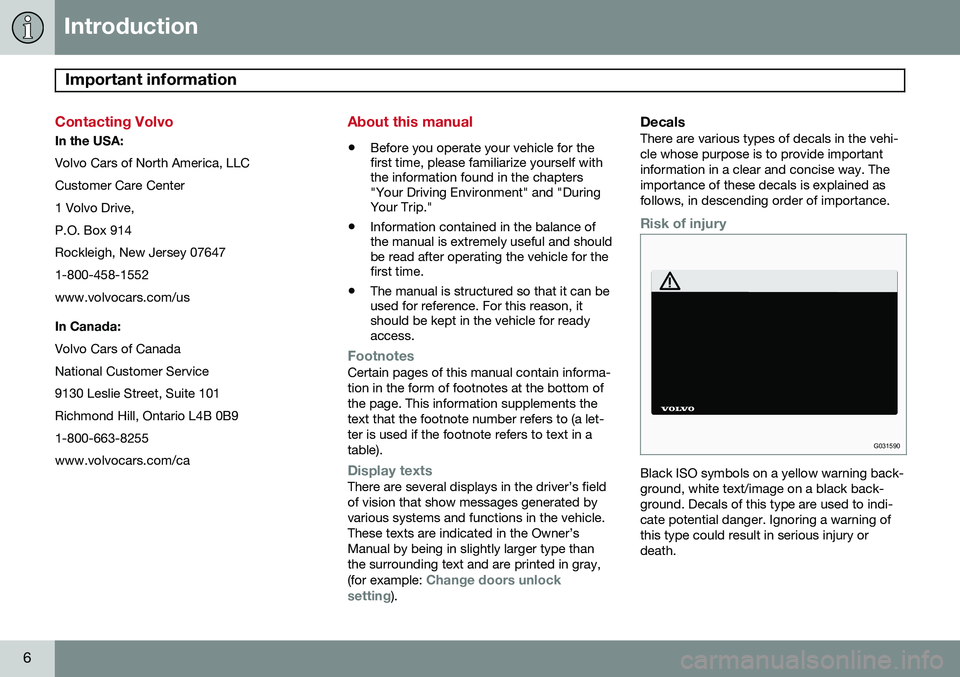
Introduction
Important information
6
Contacting Volvo
In the USA: Volvo Cars of North America, LLC Customer Care Center1 Volvo Drive,P.O. Box 914Rockleigh, New Jersey 076471-800-458-1552www.volvocars.com/us In Canada: Volvo Cars of Canada National Customer Service9130 Leslie Street, Suite 101Richmond Hill, Ontario L4B 0B91-800-663-8255www.volvocars.com/ca
About this manual
•Before you operate your vehicle for the first time, please familiarize yourself withthe information found in the chapters"Your Driving Environment" and "DuringYour Trip."
• Information contained in the balance ofthe manual is extremely useful and shouldbe read after operating the vehicle for thefirst time.
• The manual is structured so that it can beused for reference. For this reason, itshould be kept in the vehicle for readyaccess.
FootnotesCertain pages of this manual contain informa- tion in the form of footnotes at the bottom ofthe page. This information supplements thetext that the footnote number refers to (a let-ter is used if the footnote refers to text in atable).
Display textsThere are several displays in the driver’s field of vision that show messages generated byvarious systems and functions in the vehicle.These texts are indicated in the Owner’sManual by being in slightly larger type thanthe surrounding text and are printed in gray, (for example:
Change doors unlock
setting).
DecalsThere are various types of decals in the vehi- cle whose purpose is to provide importantinformation in a clear and concise way. Theimportance of these decals is explained asfollows, in descending order of importance.
Risk of injury
G031590
Black ISO symbols on a yellow warning back- ground, white text/image on a black back-ground. Decals of this type are used to indi-cate potential danger. Ignoring a warning ofthis type could result in serious injury ordeath.
Page 11 of 406
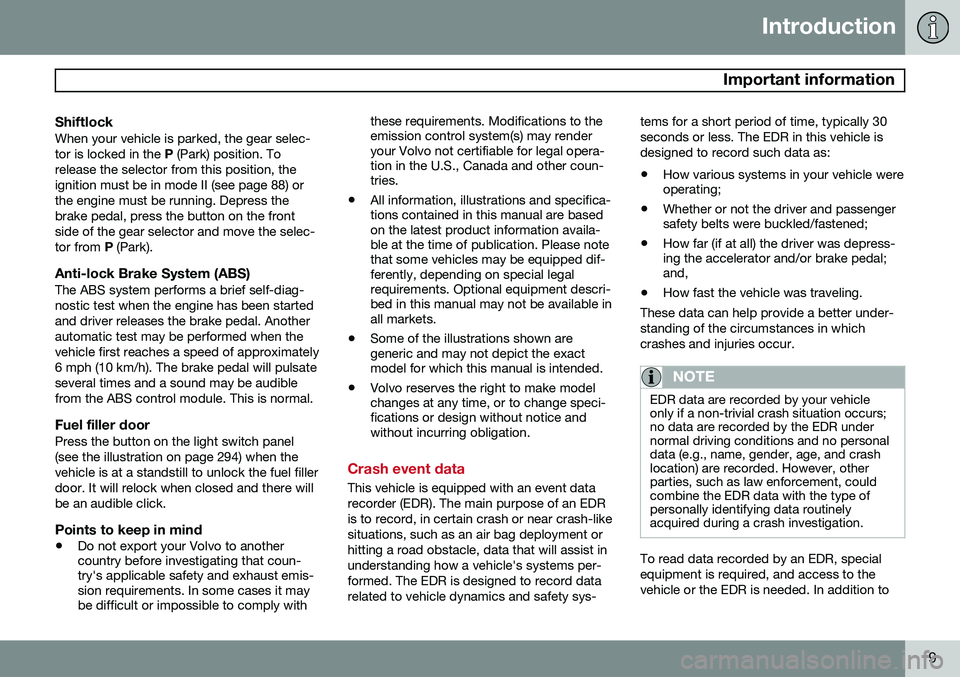
Introduction
Important information
9
ShiftlockWhen your vehicle is parked, the gear selec- tor is locked in the P (Park) position. To
release the selector from this position, theignition must be in mode II (see page 88) orthe engine must be running. Depress thebrake pedal, press the button on the frontside of the gear selector and move the selec-tor from P (Park).
Anti-lock Brake System (ABS)The ABS system performs a brief self-diag-nostic test when the engine has been startedand driver releases the brake pedal. Anotherautomatic test may be performed when thevehicle first reaches a speed of approximately6 mph (10 km/h). The brake pedal will pulsateseveral times and a sound may be audiblefrom the ABS control module. This is normal.
Fuel filler doorPress the button on the light switch panel(see the illustration on page 294) when thevehicle is at a standstill to unlock the fuel fillerdoor. It will relock when closed and there willbe an audible click.
Points to keep in mind
• Do not export your Volvo to another country before investigating that coun-try's applicable safety and exhaust emis-sion requirements. In some cases it maybe difficult or impossible to comply with these requirements. Modifications to theemission control system(s) may renderyour Volvo not certifiable for legal opera-tion in the U.S., Canada and other coun-tries.
• All information, illustrations and specifica-tions contained in this manual are basedon the latest product information availa-ble at the time of publication. Please notethat some vehicles may be equipped dif-ferently, depending on special legalrequirements. Optional equipment descri-bed in this manual may not be available inall markets.
• Some of the illustrations shown aregeneric and may not depict the exactmodel for which this manual is intended.
• Volvo reserves the right to make modelchanges at any time, or to change speci-fications or design without notice andwithout incurring obligation.
Crash event data
This vehicle is equipped with an event data recorder (EDR). The main purpose of an EDRis to record, in certain crash or near crash-likesituations, such as an air bag deployment orhitting a road obstacle, data that will assist inunderstanding how a vehicle's systems per-formed. The EDR is designed to record datarelated to vehicle dynamics and safety sys- tems for a short period of time, typically 30seconds or less. The EDR in this vehicle isdesigned to record such data as:
• How various systems in your vehicle were operating;
• Whether or not the driver and passengersafety belts were buckled/fastened;
• How far (if at all) the driver was depress-ing the accelerator and/or brake pedal;and,
• How fast the vehicle was traveling.
These data can help provide a better under- standing of the circumstances in whichcrashes and injuries occur.
NOTE
EDR data are recorded by your vehicle only if a non-trivial crash situation occurs;no data are recorded by the EDR undernormal driving conditions and no personaldata (e.g., name, gender, age, and crashlocation) are recorded. However, otherparties, such as law enforcement, couldcombine the EDR data with the type ofpersonally identifying data routinelyacquired during a crash investigation.
To read data recorded by an EDR, special equipment is required, and access to thevehicle or the EDR is needed. In addition to
Page 16 of 406
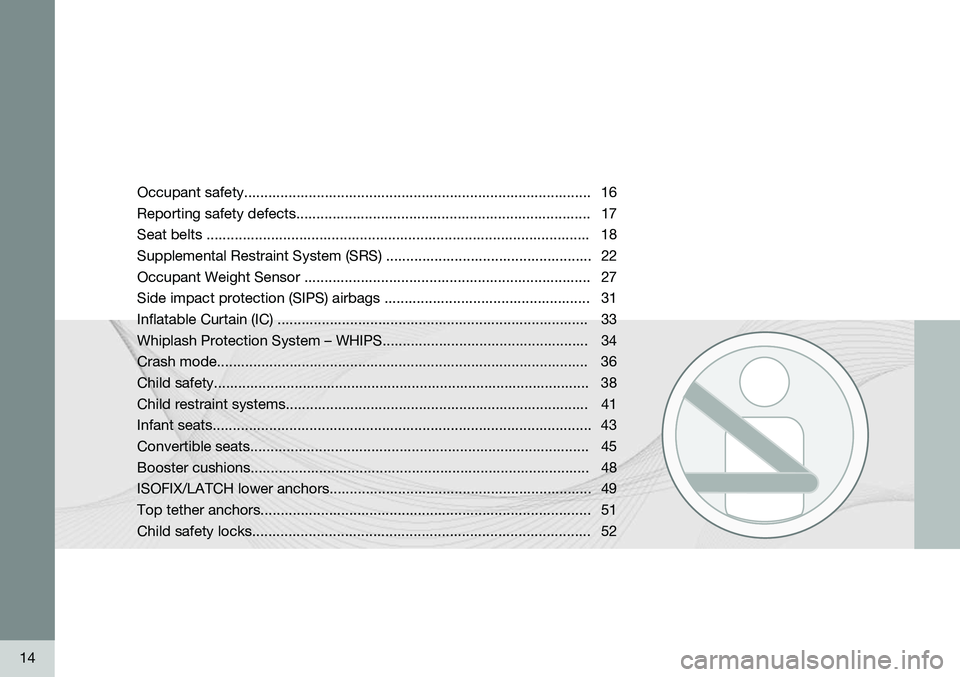
14
Occupant safety...................................................................................... 16
Reporting safety defects......................................................................... 17Seat belts ............................................................................................... 18
Supplemental Restraint System (SRS) ................................................... 22
Occupant Weight Sensor ....................................................................... 27
Side impact protection (SIPS) airbags ................................................... 31Inflatable Curtain (IC) ............................................................................. 33
Whiplash Protection System – WHIPS................................................... 34Crash mode............................................................................................ 36Child safety............................................................................................. 38
Child restraint systems........................................................................... 41Infant seats.............................................................................................. 43Convertible seats.................................................................................... 45
Booster cushions....................................................................................48
ISOFIX/LATCH lower anchors................................................................. 49
Top tether anchors..................................................................................51Child safety locks.................................................................................... 52
Page 20 of 406
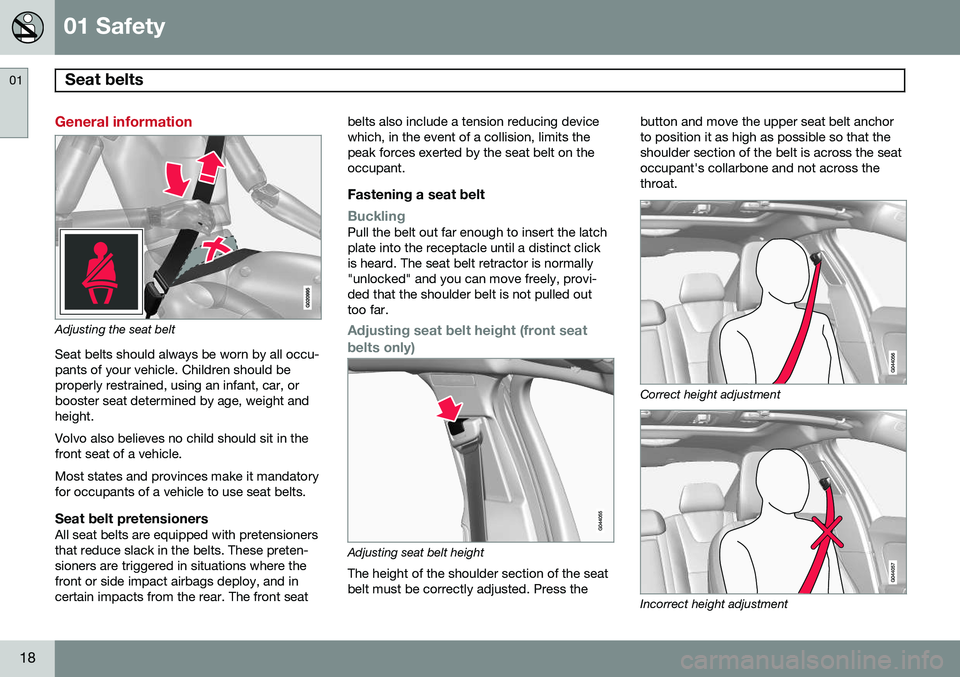
01 Safety
Seat belts 01
18
General information
Adjusting the seat beltSeat belts should always be worn by all occu- pants of your vehicle. Children should beproperly restrained, using an infant, car, orbooster seat determined by age, weight andheight. Volvo also believes no child should sit in the front seat of a vehicle. Most states and provinces make it mandatory for occupants of a vehicle to use seat belts.
Seat belt pretensionersAll seat belts are equipped with pretensionersthat reduce slack in the belts. These preten-sioners are triggered in situations where thefront or side impact airbags deploy, and incertain impacts from the rear. The front seat belts also include a tension reducing devicewhich, in the event of a collision, limits thepeak forces exerted by the seat belt on theoccupant.
Fastening a seat belt
BucklingPull the belt out far enough to insert the latch plate into the receptacle until a distinct clickis heard. The seat belt retractor is normally"unlocked" and you can move freely, provi-ded that the shoulder belt is not pulled outtoo far.
Adjusting seat belt height (front seat
belts only)
Adjusting seat belt height
The height of the shoulder section of the seat belt must be correctly adjusted. Press the button and move the upper seat belt anchorto position it as high as possible so that theshoulder section of the belt is across the seatoccupant's collarbone and not across thethroat.
Correct height adjustment
Incorrect height adjustment
Page 21 of 406
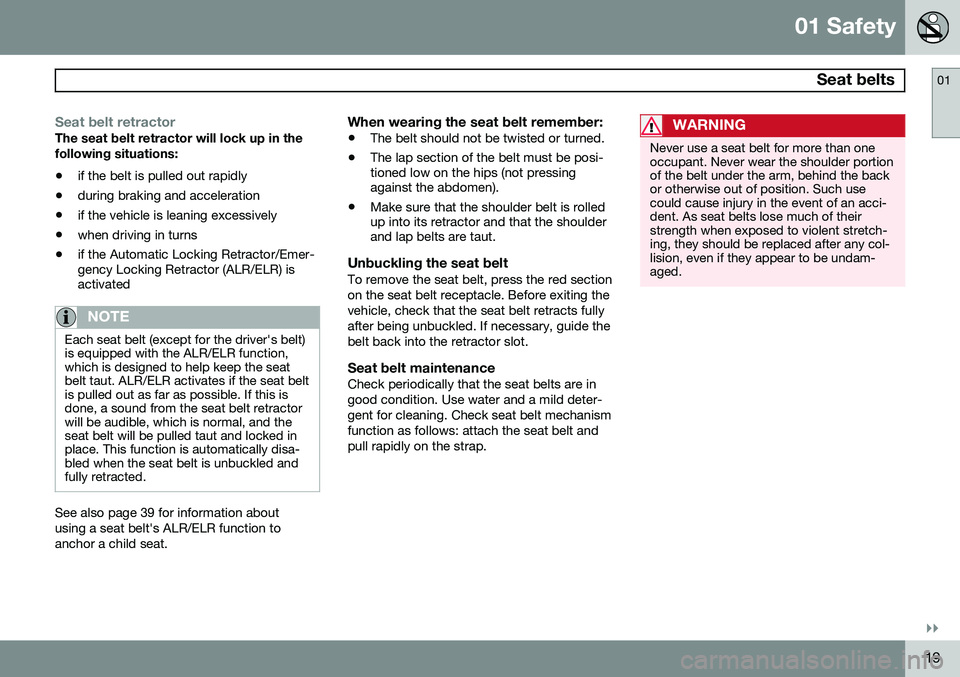
01 Safety
Seat belts01
}}
19
Seat belt retractorThe seat belt retractor will lock up in the following situations:• if the belt is pulled out rapidly
• during braking and acceleration
• if the vehicle is leaning excessively
• when driving in turns
• if the Automatic Locking Retractor/Emer- gency Locking Retractor (ALR/ELR) isactivated
NOTE
Each seat belt (except for the driver's belt) is equipped with the ALR/ELR function,which is designed to help keep the seatbelt taut. ALR/ELR activates if the seat beltis pulled out as far as possible. If this isdone, a sound from the seat belt retractorwill be audible, which is normal, and theseat belt will be pulled taut and locked inplace. This function is automatically disa-bled when the seat belt is unbuckled andfully retracted.
See also page 39 for information about using a seat belt's ALR/ELR function toanchor a child seat.
When wearing the seat belt remember:
• The belt should not be twisted or turned.
• The lap section of the belt must be posi- tioned low on the hips (not pressingagainst the abdomen).
• Make sure that the shoulder belt is rolledup into its retractor and that the shoulderand lap belts are taut.
Unbuckling the seat beltTo remove the seat belt, press the red section on the seat belt receptacle. Before exiting thevehicle, check that the seat belt retracts fullyafter being unbuckled. If necessary, guide thebelt back into the retractor slot.
Seat belt maintenanceCheck periodically that the seat belts are ingood condition. Use water and a mild deter-gent for cleaning. Check seat belt mechanismfunction as follows: attach the seat belt andpull rapidly on the strap.
WARNING
Never use a seat belt for more than one occupant. Never wear the shoulder portionof the belt under the arm, behind the backor otherwise out of position. Such usecould cause injury in the event of an acci-dent. As seat belts lose much of theirstrength when exposed to violent stretch-ing, they should be replaced after any col-lision, even if they appear to be undam-aged.
Page 25 of 406
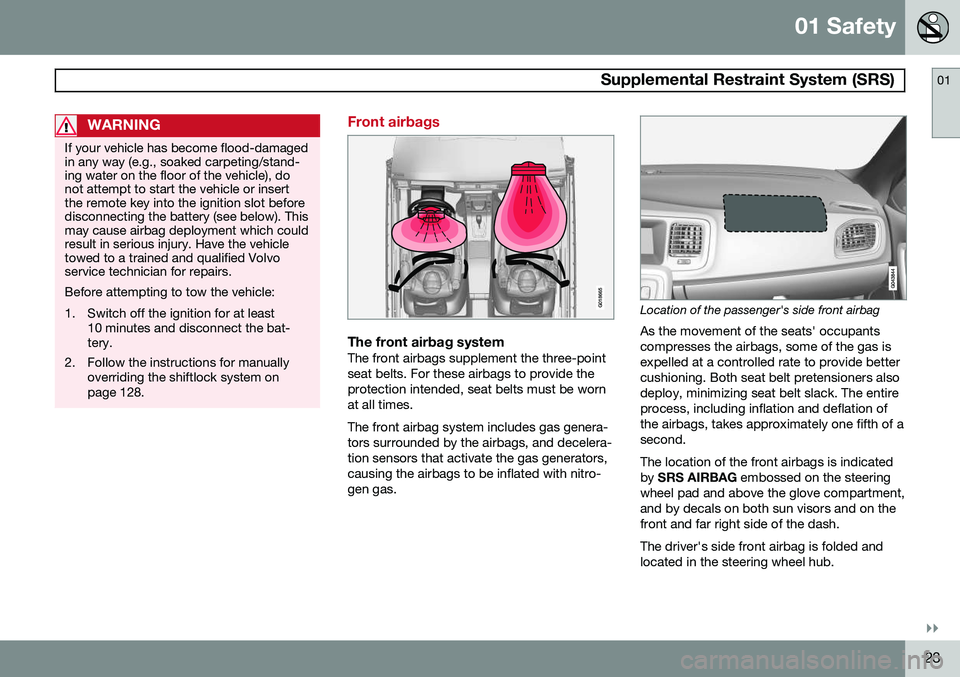
01 Safety
Supplemental Restraint System (SRS)01
}}
23
WARNING
If your vehicle has become flood-damaged in any way (e.g., soaked carpeting/stand-ing water on the floor of the vehicle), donot attempt to start the vehicle or insertthe remote key into the ignition slot beforedisconnecting the battery (see below). Thismay cause airbag deployment which couldresult in serious injury. Have the vehicletowed to a trained and qualified Volvoservice technician for repairs. Before attempting to tow the vehicle:
1. Switch off the ignition for at least10 minutes and disconnect the bat- tery.
2. Follow the instructions for manually overriding the shiftlock system onpage 128.
Front airbags
G018665
The front airbag systemThe front airbags supplement the three-point seat belts. For these airbags to provide theprotection intended, seat belts must be wornat all times. The front airbag system includes gas genera- tors surrounded by the airbags, and decelera-tion sensors that activate the gas generators,causing the airbags to be inflated with nitro-gen gas.
Location of the passenger's side front airbag
As the movement of the seats' occupants compresses the airbags, some of the gas isexpelled at a controlled rate to provide bettercushioning. Both seat belt pretensioners alsodeploy, minimizing seat belt slack. The entireprocess, including inflation and deflation ofthe airbags, takes approximately one fifth of asecond. The location of the front airbags is indicated by SRS AIRBAG embossed on the steering
wheel pad and above the glove compartment,and by decals on both sun visors and on thefront and far right side of the dash. The driver's side front airbag is folded and located in the steering wheel hub.
Page 32 of 406
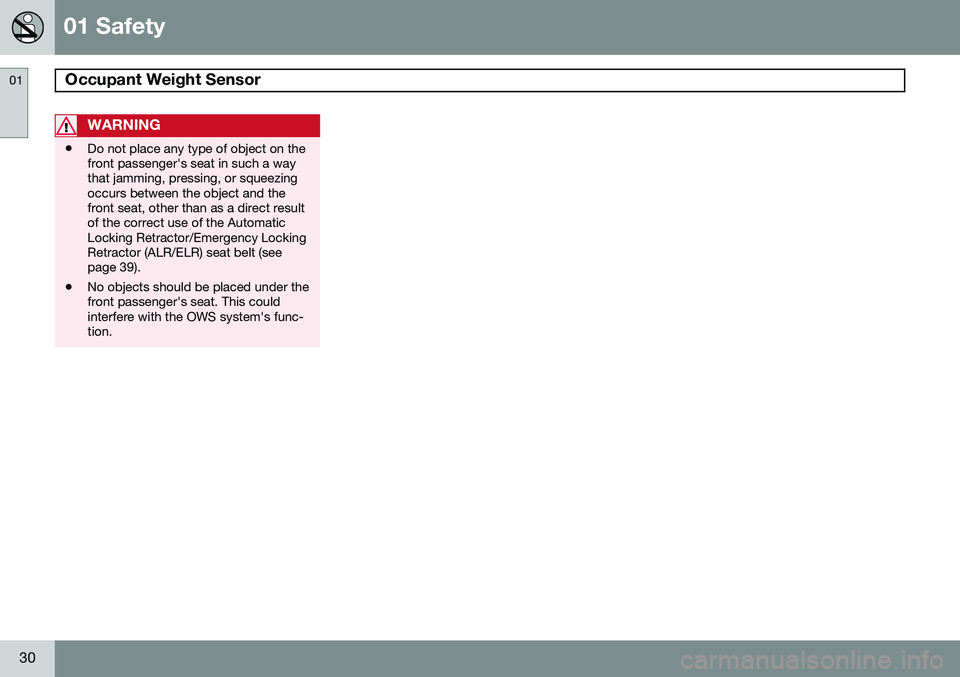
01 Safety
Occupant Weight Sensor 01
30
WARNING
•Do not place any type of object on the front passenger's seat in such a waythat jamming, pressing, or squeezingoccurs between the object and thefront seat, other than as a direct resultof the correct use of the AutomaticLocking Retractor/Emergency LockingRetractor (ALR/ELR) seat belt (seepage 39).
• No objects should be placed under thefront passenger's seat. This couldinterfere with the OWS system's func-tion.
Page 39 of 406
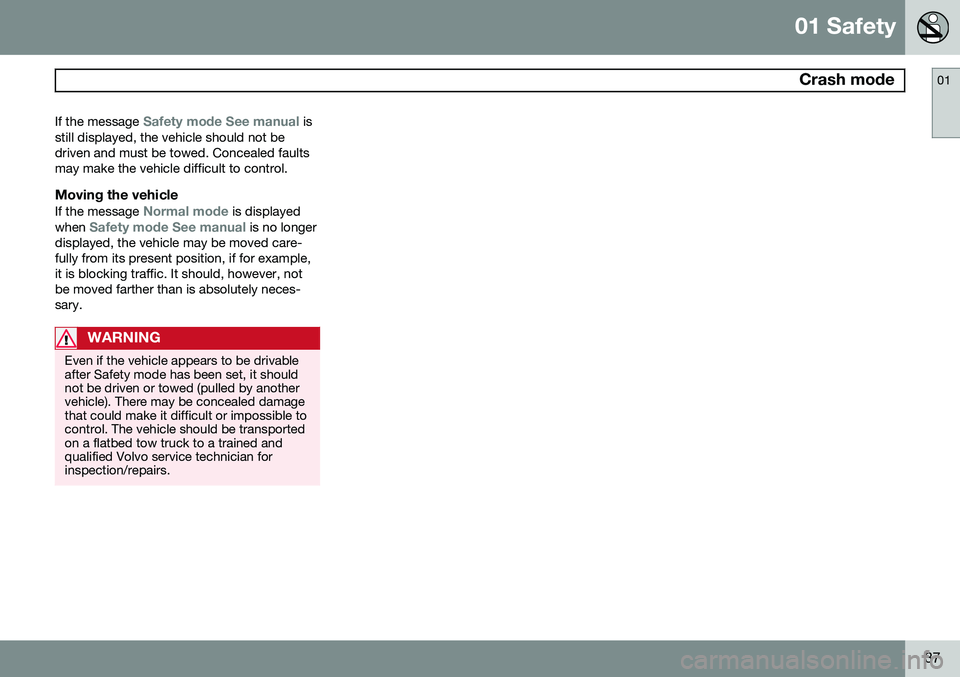
01 Safety
Crash mode01
37
If the message
Safety mode See manual is
still displayed, the vehicle should not be driven and must be towed. Concealed faultsmay make the vehicle difficult to control.
Moving the vehicle
If the message Normal mode is displayed
when Safety mode See manual is no longer
displayed, the vehicle may be moved care- fully from its present position, if for example,it is blocking traffic. It should, however, notbe moved farther than is absolutely neces-sary.
WARNING
Even if the vehicle appears to be drivable after Safety mode has been set, it shouldnot be driven or towed (pulled by anothervehicle). There may be concealed damagethat could make it difficult or impossible tocontrol. The vehicle should be transportedon a flatbed tow truck to a trained andqualified Volvo service technician forinspection/repairs.
Page 41 of 406

01 Safety
Child safety01
}}
39
WARNING
•Do not use child safety seats or child booster cushions/backrests in thefront passenger's seat. We also rec-ommend that children under 4 feet7 inches (140 cm) in height who haveoutgrown these devices sit in the rearseat with the seat belt fastened.
• Keep vehicle doors and trunk lockedand keep remote controls out of achild’s reach. Unsupervised childrencould lock themselves in an opentrunk and risk injury. Children shouldbe taught not to play in vehicles.
• On hot days, the temperature in thevehicle interior can rise very quickly.Exposure to these high temperaturesfor even a short period of time cancause heat-related injury or death.Small children are particularly at risk.
Child seat should always be registered. See page 40 for more information.
Automatic Locking Retractor/ Emergency Locking Retractor (ALR/ELR)
To make child seat installation easier, each seat belt (except for the driver's belt) is equip-ped with a locking mechanism to help keepthe seat belt taut.
When attaching the seat belt to a child
seat:
1. Attach the seat belt to the child seat according to the child seat manufactur-er's instructions.
2. Pull the seat belt out as far as possible.
3. Insert the seat belt latch plate into the buckle (lock) in the usual way.
4. Release the seat belt and pull it taut around the child seat.
A sound from the seat belt retractor will be audible at this time and is normal. The beltwill now be locked in place. This function isautomatically disabled when the seat belt isunlocked and the belt is fully retracted.
WARNING
Do not use child safety seats or child booster cushions/backrests in the frontpassenger's seat. We also recommendthat children who have outgrown thesedevices sit in the rear seat with the seatbelt properly fastened.
Volvo's recommendations
Why does Volvo believe that no child should sit in the front seat of a car? It's quite simplereally. A front airbag is a very powerful devicedesigned, by law, to help protect an adult. Because of the size of the airbag and its speed of inflation, a child should never beplaced in the front seat, even if he or she isproperly belted or strapped into a child safetyseat. Volvo has been an innovator in safetyfor over seventy-five years, and we'll continueto do our part. But we need your help. Pleaseremember to put your children in the backseat, and buckle them up.
Volvo has some very specific recommendations:
• Always wear your seat belt.
• Airbags are a SUPPLEMENTAL safety device which, when used with a three-point seat belt can help reduce seriousinjuries during certain types of accidents.